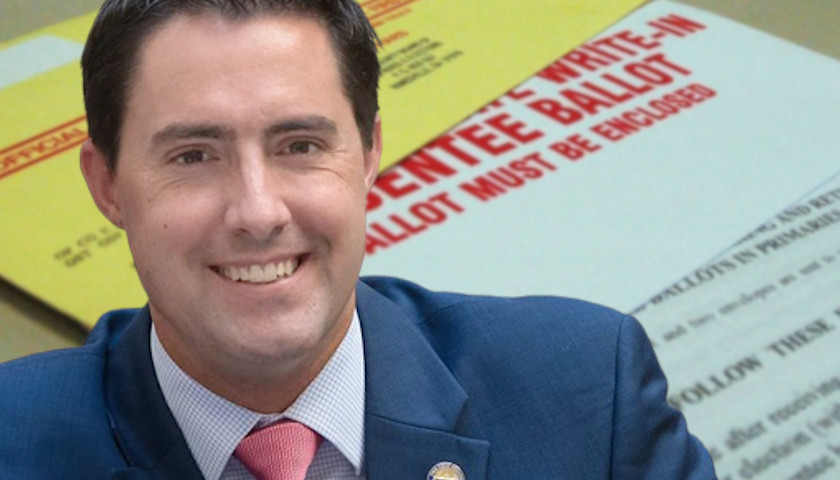Facebook buzzed on September 1 as many Ohioans received absentee ballot applications – the state’s primary step in equipping voters who want to vote absentee with the needed paperwork.
The post received 230 comments. A few:
- “This was done in 2016 for sure. See article.
- “We’ve never gotten them b4 this year & we’ve received 3 each, my husband and I. Plus we received ballot applications for 3 of the previous owners.”
- “Pretty scary though when I get one for a person that does not live at my house yet her name and address is to my house. So I could vote for both of us maybe?? Scary stuff if that is the case.”
- “I received one yesterday. I do not recall getting one in the past, but honestly I probably never paid attention since I always vote in person.”
- “True.”
In an email exchange with The Ohio Star, Maggie Sheehan, the press secretary for Secretary of State Frank LaRose, said “absentee ballot request forms have been sent in every even-year Ohio general election since 2012.
The only thing different this year is the design is more user-friendly. Click here to see a copy of the design.”
When asked how many Ohioans traditionally vote absentee, LaRose’s spokesperson said “[i]n presidential election years, traditionally 20-25 percent of Ohioans vote absentee by mail. The Secretary has told county boards to prepare for that number to double.”
In an August 12 press conference Secretary of State LaRose said in-person voting would occur and mail-in voting would be safe.
Just six days later LaRose seemed to add a stipulation to his remarks when he said “[j]ust want to make sure that the message goes out loud and clear that masks are required at Ohio voting locations. They’re required for both our elections officials and they’re required for the voters who come.”
That second statement on August 18 and a subsequent story seemed to indicate that voting in-person would happen if only a voter chose to wear a mask.
Ohioans immediately speculated whether that statement – if true – would be a voter right violation if a voter ended up being turned away for not wearing a mask.
Secretary LaRose immediately took to Facebook to clear the air.
The Star asked this question to Sheehan:
“Regarding in-person voting: if a voter arrives without a mask, refuses the offered mask and refuses to vote curbside – is the person allowed to vote in the booth or would s/he be denied?”
Sheehan replied: “In the scenario you describe, yes that individual would be able to cast their ballot inside. You can see Secretary LaRose’s statement on the use of masks while voting below.”
There appears to be some misinformation out there regarding the governor’s mask mandate and how it relates to voting this fall. As I’ve said all along, this is what voters should expect… pic.twitter.com/PpYSU6AnPd
— Frank LaRose (@FrankLaRose) August 18, 2020
“Whether you’re voting on election day, early in-person, or taking advantage of the absentee request form arriving this week in your mailbox, Ohioans should know voting will be safe and secure in Ohio,” wrote LaRose in a September 1 press release. “With the convenience of voting from home comes a responsibility – don’t wait to make your voice heard. Get your ballot request form in the mail as soon as you can.”
From the White House to the Ohio Statehouse leaders sounded the alarm about the risk of fraud for mail-in and widely used absentee methods.
Research suggests that in-person voting may be safer than previously believed amidst the COVID epidemic.
During the 2016 presidential election, almost one-fourth of voters mailed-in absentee ballots and 41% voted early. A study suggests the fraud risk for mail-in voting is slightly larger than in-person manipulation.
In a tight election in which every vote can swing the result, even a slight advantage can change the outcome – especially if the mail-in volume is twice previous levels.
This may be a moot point to the 21,000 Ohioans who lost their vote just a few months ago in the primary election.
Yet despite that, perhaps the greater risk regarding election manipulation doesn’t involve ballots as much as it does influence.
If statements made to the Senate Judiciary Committee’s Subcommittee on the Constitution by Dr. Robert Epstein are correct, ballots pale in comparison to big technology influence – Google and Facebook.
As reported yesterday in The Star, Big Tech manipulation, according to Epstein, tilted 2.6 to 10.4 million votes to Hillary Clinton.
In the September 1 press release, LaRose addressed the concern about absentee voting by saying, “[A]bsentee voting in Ohio is time-tested and has strong security checks in place.
Ohioans have utilized absentee voting for nearly two decades, and that has allowed Ohio to put in place both the laws and processes necessary to make absentee voting secure against fraud.
- Voter identification and signature are checked TWICE during the process
- Voter list maintenance allows for accurate voter rolls
- Ballot harvesting is against the law in Ohio
- Voters are able to track their ballot here.
These requirements and processes, as well as strict laws against voter fraud, have made absentee voting secure in Ohio and instances of voter fraud exceedingly rare.”
The United States presidential election is 61 days away.
– – –
Jack Windsor is Managing Editor and an Investigative Reporter at The Ohio Star. Windsor is also an Investigative Reporter at WMFD-TV. Follow Jack on Twitter. Email tips to [email protected].
Photo “Frank LaRose” by Frank LaRose.





